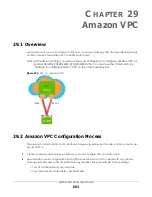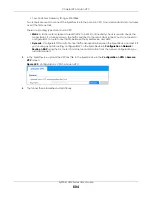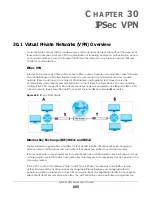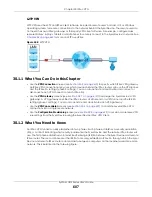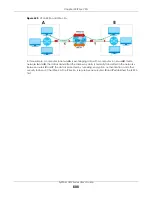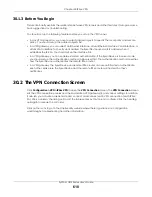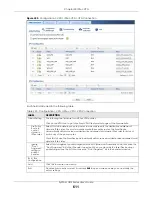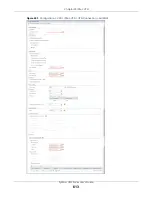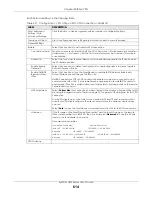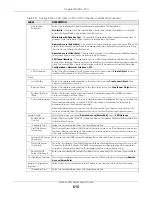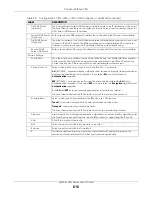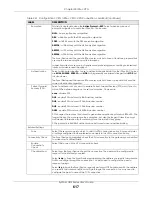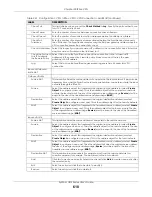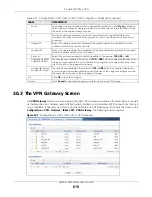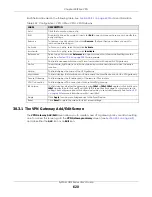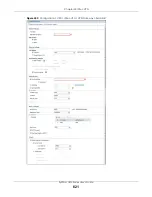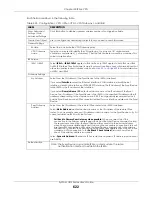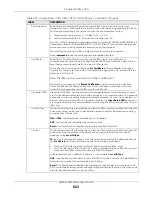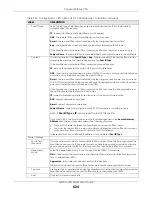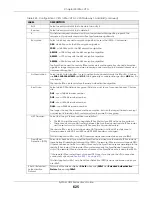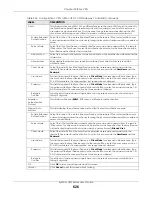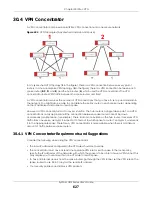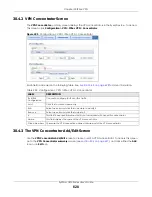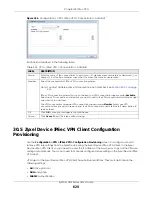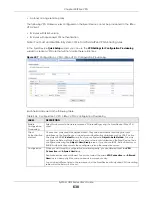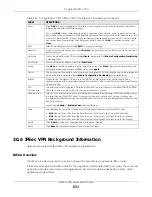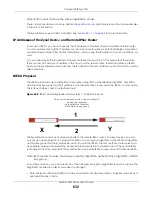
Chapter 30 IPSec VPN
ZyWALL USG Series User’s Guide
617
Encryption
This field is applicable when the
Active Protocol
is
ESP
. Select which key size and
encryption algorithm to use in the IPSec SA. Choices are:
NULL
- no encryption key or algorithm
DES
- a 56-bit key with the DES encryption algorithm
3DES
- a 168-bit key with the DES encryption algorithm
AES128
- a 128-bit key with the AES encryption algorithm
AES192
- a 192-bit key with the AES encryption algorithm
AES256
- a 256-bit key with the AES encryption algorithm
The Zyxel Device and the remote IPSec router must both have at least one proposal that
uses use the same encryption and the same key.
Longer keys are more secure, but require more processing power, resulting in increased
latency and decreased throughput.
Authentication
Select which hash algorithm to use to authenticate packet data in the IPSec SA. Choices
are
SHA1
,
SHA256
,
SHA512
and
MD5
. SHA is generally considered stronger than
MD5
, but
it is also slower.
The Zyxel Device and the remote IPSec router must both have a proposal that uses the
same authentication algorithm.
Perfect Forward
Secrecy (PFS)
Select whether or not you want to enable Perfect Forward Secrecy (PFS) and, if you do,
which Diffie-Hellman key group to use for encryption. Choices are:
none
- disable PFS
DH1
- enable PFS and use a 768-bit random number
DH2
- enable PFS and use a 1024-bit random number
DH5
- enable PFS and use a 1536-bit random number
DH14
- enable PFS and use a 2048 bit random number
PFS changes the root key that is used to generate encryption keys for each IPSec SA. The
longer the key, the more secure the encryption, but also the longer it takes to encrypt
and decrypt information. Both routers must use the same DH key group.
PFS is ignored in initial IKEv2 authentication but is used when re-authenticating.
Related Settings
Zone
Select the security zone into which to add this VPN connection policy. Any security rules
or settings configured for the selected zone apply to this VPN connection policy.
Connectivity Check
The Zyxel Device can regularly check the VPN connection to the gateway you specified
to make sure it is still available.
Enable
Connectivity
Check
Select this to turn on the VPN connection check.
Check Method
Select how the Zyxel Device checks the connection. The peer must be configured to
respond to the method you select.
Select
icmp
to have the Zyxel Device regularly ping the address you specify to make sure
traffic can still go through the connection. You may need to configure the peer to
respond to pings.
Select
tcp
to have the Zyxel Device regularly perform a TCP handshake with the address
you specify to make sure traffic can still go through the connection. You may need to
configure the peer to accept the TCP connection.
Table 221 Configuration > VPN > IPSec VPN > VPN Connection > Add/Edit (continued)
LABEL
DESCRIPTION
Summary of Contents for USG110
Page 27: ...27 PART I User s Guide ...
Page 195: ...195 PART II Technical Reference ...
Page 309: ...Chapter 10 Interfaces ZyWALL USG Series User s Guide 309 ...
Page 313: ...Chapter 10 Interfaces ZyWALL USG Series User s Guide 313 ...
Page 358: ...Chapter 10 Interfaces ZyWALL USG Series User s Guide 358 ...
Page 373: ...Chapter 10 Interfaces ZyWALL USG Series User s Guide 373 ...

